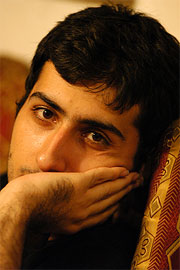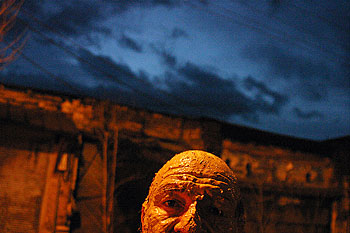 |
 | |||||||
The Soil Dance
April 2006 |
 |
||||||
|
In Iran there are many special religious ceremonies held each year. The most important one for Iranians comes in Moharam [roughly the western Feb./March], the first month of the Islamic calendar when on the 10th day of the month Imam Hussein, the third Imam, and 72 of his followers were killed for their beliefs. His family was captured by the enemy army. This day marks the beginning of Ashura. Every year during this month Muslims mourn to keep alive the memory of the Imam and his martyrdom. The mourning rituals of Ashura are very different in each part of Iran. Ceremonies have grown out of the history and culture of each region over the centuries.
In this particular place, men make pools of mud by digging dirt out of the ground and returning some of the loose soil, mixed with water, creating mud baths. The sight of the men moving around the brown pools, scooping up the mud and slapping it on to themselves begins to look like a dance. For me, they were dancing with the earth. A fire is started and they stand around it until the sun rises, as the mud dries and tightens its grip on their bodies. The men said, "When we coat ourselves with the rough mud we remember that we were created from the earth's soil. When we draw together around the fire, we all mourn. We believe that God is in the society and not in the individual; we know that we need each other."
One local man named "Sayed" had accompanied me. He insisted that I go to his home rather than the hotel. This was fortunate because I could be closer to the people. They shared their ideas more comfortably in private than in public. I experienced firsthand both their laughter and the tears in their eyes. I believe that everything in the world is dancing, from the earth dancing around the sun to a single leaf drifting to the ground. Dancing releases me from my body and I try to get closer to the soul. Dancing and mourning share this because they both release the soul from its cage. There are two problems facing these rituals: first, while they are often covered, the internal media does not use the images, and second, the influence of the mass media has gradually eroded these unique rituals. How will children learn to appreciate their native culture in a world of media, big business and world trade? Most Iranians know nothing about Khorramabadi's ceremony and the philosophy behind it. Maybe it is our duty not to let rituals such as these be forgotten.
© Ali Akbar Shirjian
Dispatches are brought to you by Canon. Send Canon a message of thanks. |
|||||||
Back to April 2006 Contents
|
|


